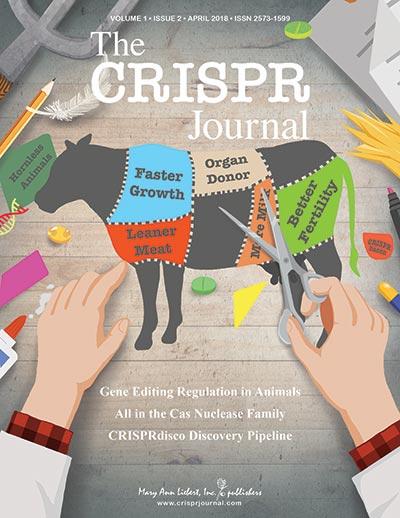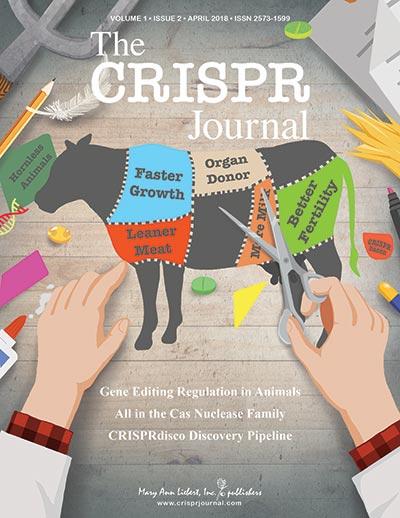
Credit: Mary Ann Liebert, Inc., publishers
The CRISPR Journal, a new peer-reviewed journal from Mary Ann Liebert, Inc., publishers, announces the publication of its third issue. The Journal is dedicated to validating and publishing outstanding research and commentary on all aspects of CRISPR and gene editing, including CRISPR biology, technology and genome editing, and commentary and debate of key policy, regulatory, and ethical issues affecting the field. The Journal, led by Editor-in-Chief Rodolphe Barrangou, PhD (North Carolina State University) and Executive Editor Dr. Kevin Davies, is published bimonthly online and in print. See http://www.crisprjournal.com for more information. This press release is copyright Mary Ann Liebert, Inc. Its use is granted only for journalists and news media receiving it directly from The CRISPR Journal. For full-text copies of articles or to arrange interviews with Dr. Barrangou, Dr. Davies, authors, or members of the editorial board, contact Kathryn Ryan at the Publisher.
1. TIE, a novel technique for delivery of long DNA templates for CRISPR-Cas9 gene editing
While off-target and immunological side-effects are key safety areas to address in translational CRISPR research, another major challenge is delivery. To overcome the traditional size limitations of delivering the CRISPR-Cas machinery to fertilized mouse eggs using a method called electroporation, researchers at McGill University have developed an innovative two-step strategy which pre-injects all CRISPR-related components, including long plasmid-sized DNA templates, into the sub-zona pellucida space. The retention of the components at sufficient concentrations was visualized using fluorescence microscopy. The technique enabled subsequent electroporation, advocating for its use as an alternative approach for transfecting zygotes and preimplantation embryos.
Contact: Alan Peterson (McGill University)
2. Correction of a recessive genetic defect by Crispr-Cas9-mediated endogenous repair
The potential use of CRISPR gene editing to treat patients with genetic diseases is made more difficult in the case of recessive disorders, where both copies of a gene harbor a mutation. In some instances, so-called compound heterozygotes carry two different mutations in the same gene. A group of Italian researchers detail a potential strategy to perform CRISPR-based genome editing using an endogenous repair template that could restore at least one functional copy of the mutated gene. The team sought to correct compound heterozygous mutations by using CRISPR-Cas9 cleavage in a gene intron between the two mutations, inducing gene conversion or crossing over, thus negating the need for an exogenous repair template. Through this approach, the authors could restore function to a gene via endogenous repair and demonstrated the potential of this technique to treat a subset of recessive disorders that have two different mutations in the same gene.
Contact: Marianna Paulis (UOS/IRGB, Humanitas Clinical and Research Center, Italy)
3. EditR: A novel base editing quantification software using Sanger sequencing
There is considerable interest in a new variant of CRISPR gene editing called base editing, which can perform a targeted single-base substitution without introducing a break in the DNA. However, current analyses of base-editing outcomes rely on wet lab techniques that are costly, time consuming, and imprecise. To address this issue, researchers at the University of Minnesota have developed an alternative method – a practical software program that produces fast, accurate, superior estimates of editing results. EditR is a free web tool that requires only a single Sanger sequencing file of a base-edited sample and the sequence of the gRNA protospacer to accurately predict base editing outcomes completely in silico.
Contact: Branden S. Moriarity (University of Minnesota)
4. Leveling the CRISPR playing field
Addgene is a non-profit plasmid repository aimed at empowering researchers by granting affordable access to cutting-edge technologies. Originally envisioned as a "one-stop-shop" for scientists to deposit, store, and request bacterial plasmids, Addgene has become a key player in the democratization of CRISPR-based technologies. In this Perspective, Addgene's Caroline LaManna and The CRISPR Journal chief editor, Rodolphe Barrangou, chronicle the Addgene-enabled dissemination of CRISPR-encoding plasmids, which has facilitated researchers around the world, "regardless of socioeconomic, geographical, or scientific status," promoting the usage and further development of next-generation genome editing tools.
Contact: Caroline LaManna (Addgene, Cambridge, Massachusetts)
5. Mixing it up with @CRISPRchef
Rodolphe Barrangou, Editor-in-Chief of The CRISPR Journal and one of the pioneers of CRISPR gene editing, is the latest subject in the Journal's GuidePost Podcast series, excerpts of which are published in this issue. In conversation with Executive Editor Kevin Davies, Barrangou recounts his comprehensive CRISPR career, including his pivotal role characterizing the biological function of CRISPR loci, his academic life at North Carolina State University, and his entrepreneurial activities. He also offers insight into the future of genome editing as a whole and the role The CRISPR Journal will play in chronicling every step of the way. (The full Guidepost podcast with Barrangou is here.)
Contact: Rodolphe Barrangou (NCSU)
6. My CRISPR Story: Special Delivery
In the third installment of "My CRISPR Story," Kunwoo Lee recounts his ascent from graduate student to co-founder and CEO of the CRISPR-based company, GenEdit. Lee details the struggles of launching a biotech start-up as well as translating "scientific concepts into the language of business." GenEdit's polymer nanoparticle technology has already been exploited for efficient delivery of Cas9 and guide RNA to various tissues via direct injection, positioning Lee and colleagues to become key players in the rapidly-expanding CRISPR therapeutics field.
Contact: Kunwoo Lee (GenEdit, Berkeley, California)
7. Unite to Cure: CRISPR Comes to the Vatican
CRISPR has far reaching implications in science, politics…and now the Vatican? Executive Editor Kevin Davies reports on the "Unite to Cure" Fourth International Vatican Conference, where attendees were treated to a Papal address, celebrity cameos, and a panel discussion on genome editing featuring the CEOs of three major CRISPR biotechs, Editas, CRISPR Therapeutics, and Intellia.
Contact: Kevin Davies (The CRISPR Journal)
###
**ALL ARTICLES ARE EMBARGOED UNTIL 10:00 EST / 15:00 GMT June 18, 2018**
Media Contact
Kathryn Ryan
[email protected]
914-740-2250
@LiebertPub
http://www.liebertpub.com





